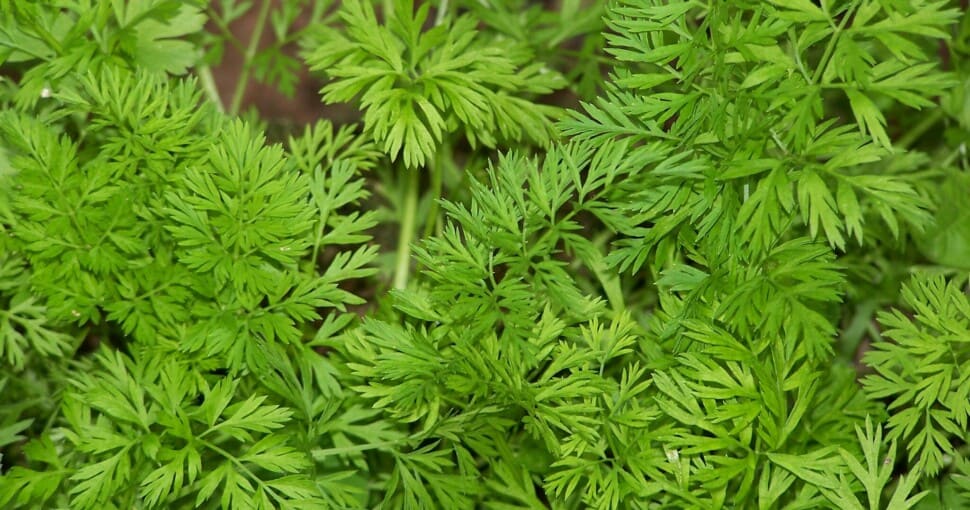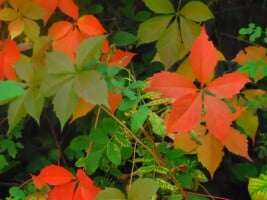Today we know carrots as a bright orange food crop, crunchy and sweet while packed with vitamins and antioxidants. Carrots have been selectively cultivated for these characteristics to eat as a root crop. History indicates that carrots (Daucus carota subsp. sativus) as we know them today were originally domesticated and grown in Persia for their leaves and seeds long before carrots became a root crop.
Contents
Carrots have an interesting history and impressive health benefits, but the green leafy part has fallen by the wayside. You might even have heard that carrot greens are toxic or inedible, but this is absolutely not the case.
Carrot leaves are an excellent source of calcium, potassium, magnesium, and Vitamin K. The leafy tops also contain much more Vitamin C than carrot roots. All these nutrients assist with healthy blood pressure levels and stronger muscles and bones.
While carrot leaves are not found in the herb section of your local greengrocer, they are an excellent substitute for herbs like parsley and rocket. They can be transformed into pesto sauce, added to salsa Verdi or chimichurri sauce for a peppery flavor, or simply sautéed and eaten in place of spinach.
You may find carrots at the store or farmer’s market with the leaves intact, or you may grow your own carrots. If so, you are set to try out some carrot leaf recipes. If you are about to try your hand at wild foraging, you need to know a few plants that look like carrot leaves.
Related: 8 Plants That Look Like Carrots
1. Wild Carrot
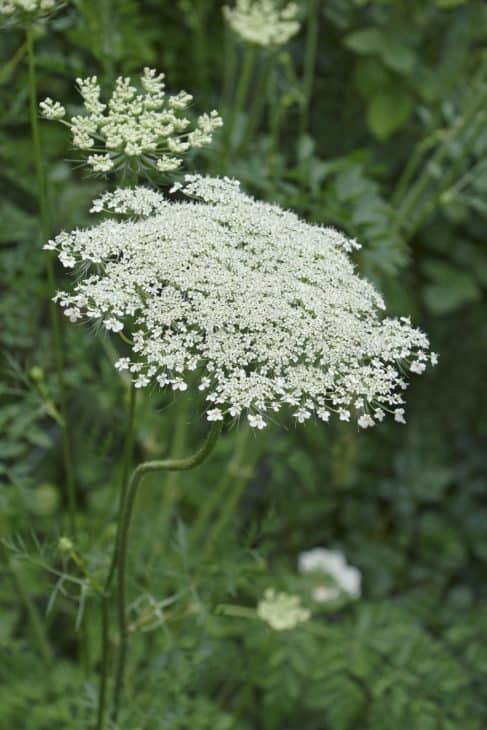
Wild carrot (Daucus carota) also goes by names like Queen Anne’s lace and bishop’s lace, which describe the lace-like texture and appearance of wild carrot leaves. The domesticated form of carrots we know today results from selectively breeding wild carrots. Therefore, it is no surprise that wild carrot leaves look the same as carrot leaves.
Wild carrot plants grow one to four feet tall with a compound pinnate leaf structure. The bright green leaves are covered with hair. Unlike domesticated carrots, the wild variety has a well-developed stem that the leaves attach to. Wild carrot roots are a whitish color and more fibrous than cultivated carrots.
The wild carrot is a biennial plant in the Apiaceae family native to Africa, Asia, and Europe. It has become naturalized in North and South America and most other continents with temperate climates. As with most plants in the Apiaceae family, wild carrots carry white flowers in an umbel or flower cluster. An umbel of wild carrot flowers usually has a single purple or red flower in the center.
2. Indian Parsley
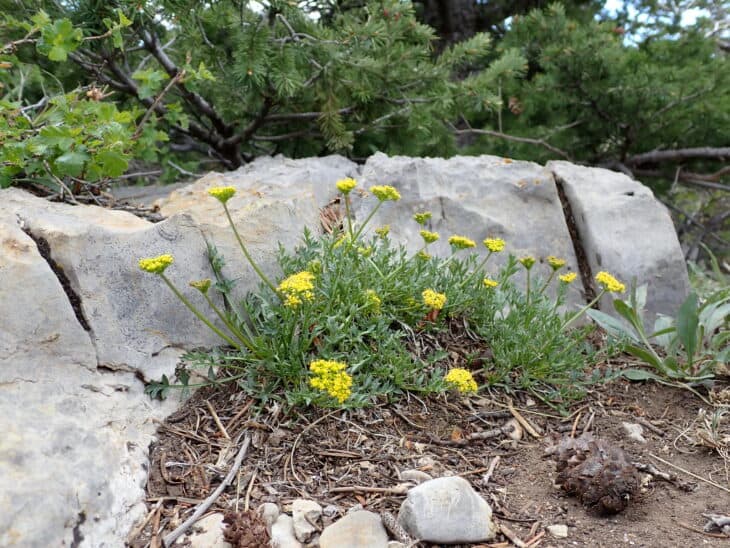
Indian parsley (Lomatium) may also be called nineleaf biscuitroot, fern leaf desert parsley, or chocolate tips. Lomatium plants are native to North America and Mexico and comprise roughly one hundred species. Biscuitroot plants were a reliable food source for Lewis and Clark while exploring America more than two hundred years ago.
Indian parsley is a perennial plant adapted to desert growth, where its leaves are only visible for a short time after the rains. Leaf shape varies by species but, in most instances, resembles flat-leafed parsley or carrot leaves with a tripinnate leaf structure.
Biscuitroot, a member of the Apiaceae family, bears its flowers on flower umbels. Indian parsley varieties’ flowers vary in color from white and yellow to red, maroon, or purple. Aside from the root being a starchy food source, Indian parsley was also used medicinally for a wide range of internal and external purposes. Notably, fern leaf biscuitroot was used for colds, pneumonia, and tuberculosis.
Related: 6 Plants That Look Like Parsley
3. Sweet Cicely
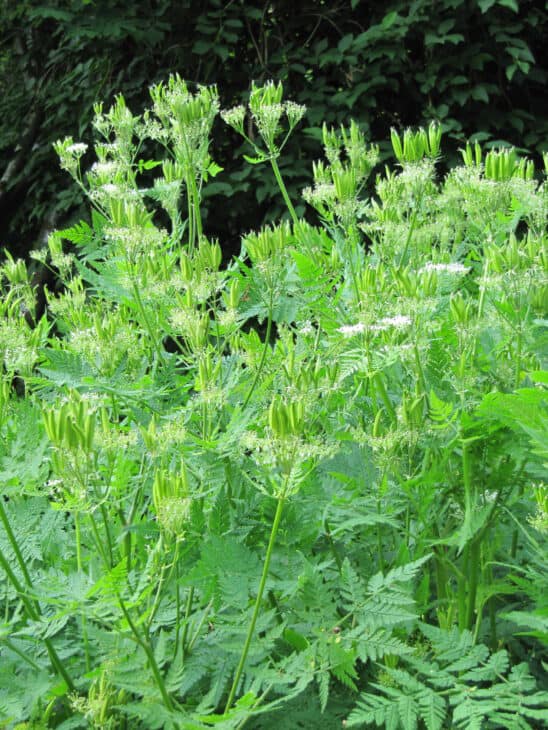
You may know sweet cicely (Myrrhis odorata) by names like sweet root and sweet chervil. Sweet cicely is a perennial plant in the same plant family as carrots. Sweet cicely is native to Central Europe, but this sweet-tasting herb has become naturalized across the globe due to escaping from herb gardens.
Sweet cicely has compound pinnate leaves shaped like carrot leaves, and the leaves are almost twenty inches long. Sweet cicely shrubs grow about six feet tall, and like carrots, the whole plant is edible. Sweet cicely has a similar taste profile to Anise and fennel.
The white flowers arranged like an umbrella are typical of plants in the Apiaceae family. As with many herbs related to carrots, sweet cicely has traditionally been used as a healing plant. Sweet cicely tea is traditionally used to assist with chest complaints, for digestion problems, and to relieve pain caused by gout.
4. Caraway
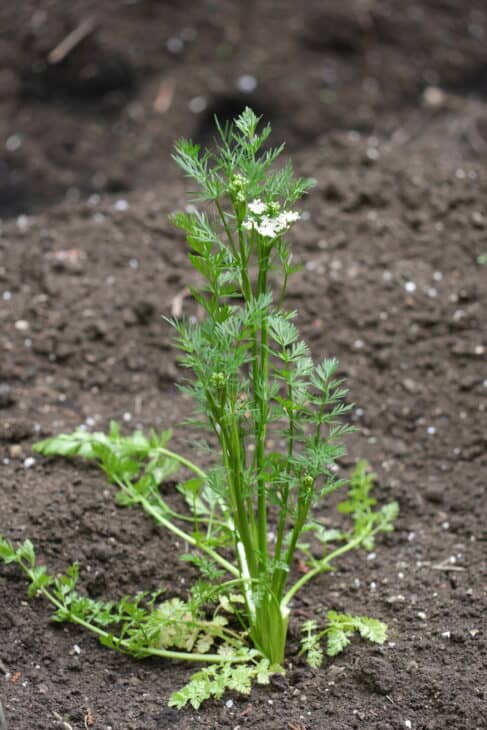
Caraway (Carum carvi) is also called Persian cumin or meridian fennel. Caraway is a carrot family member and has the same biennial growth pattern. Caraway is native to Asia, North Africa, and Europe.
Caraway has feathery carrot-shaped leaves, classified as compound pinnate. In the first growth year, the caraway plant grows around eight inches tall, as only the carrot-top-like leaves grow. After the foliage has died back in winter, new leaves and stems are produced in the second year. The stems that also carry the typical white flower umbels are more than two feet tall.
Caraway seeds are the plant part most frequently used, but the whole plant is edible. First-year leaves are tender and are ideal for including in salads, adding a fennel-like taste. Caraway roots can be used in stews after the seeds have been harvested.
5. Carrot Fern
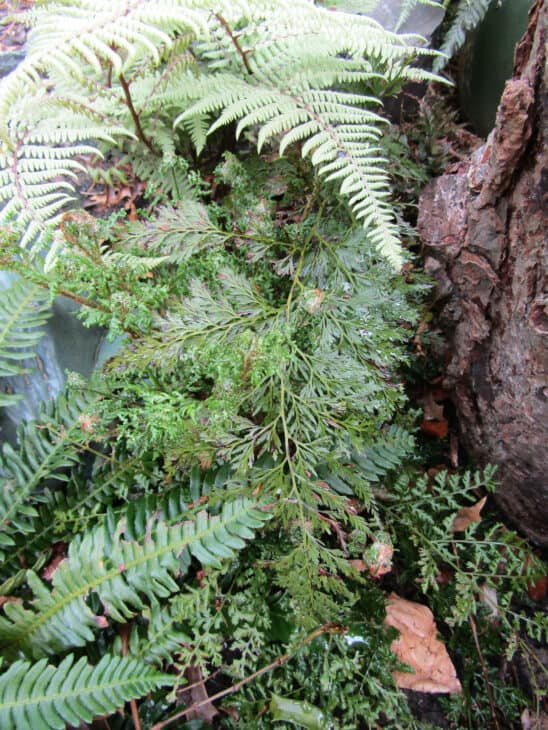
The carrot fern plant (Onychium japonicum) is a member of the fern family (Pteridaceae) and a native plant of Japan. It is also called Sichuan lace or Japanese claw fern. Carrot fern leaves are dark green and have a tripinnate leaf construction which is very similar to carrot leaves.
Carrot ferns grow between one and two feet tall with a spread of two feet. The carrot-leaf-shaped leaves are arranged on a hard, dark stem. The dark green leaves are an attractive addition to a shaded garden area.
Carrot fern is perennial and does not produce flowers or seeds, as ferns reproduce via spores. Carrot ferns grow best in temperatures that range between 75°F and 90°F. Carrot fern is not drought tolerant and requires moist but well-drained soil to thrive.
Related: 8 Plants That Look Like Ferns
6. Yarrow
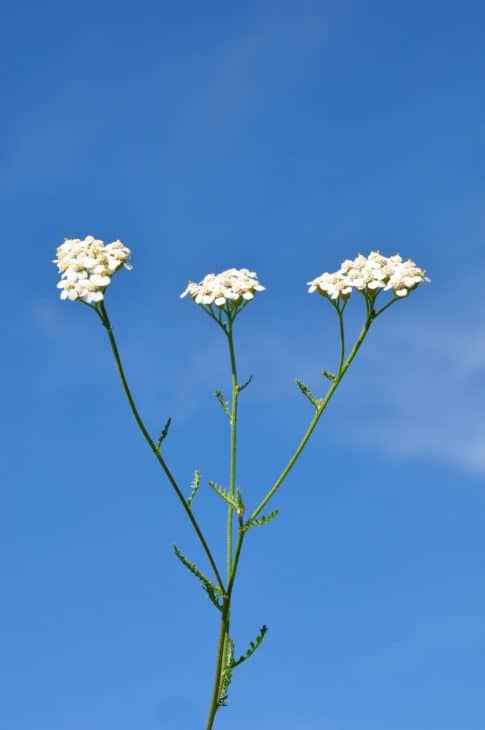
Yarrow (Achillea millefolium) is part of the Asteraceae plant family and may also be called milfoil, soldier’s woundwort (herba militaris), and devil’s nettle. Yarrow is a plant native to Europe and Asia, and according to Greek mythology, yarrow is named after Achilles, who used the herb to staunch the bleeding of wounded soldiers.
Yarrow leaves are compound pinnate in structure, appearing almost feathery, like carrot leaves, and grow between two and eight inches long. The dark green leaves grow from a hairy stem with a height of forty inches. Leaves closer to the root are bigger than the leaves near the top of the stem. Yarrow stems culminate in flower clusters ranging from white and cream to pink and red.
Like carrot flowers, yarrow attracts many pollinators and beneficial predator insects to the garden, including ladybirds and parasite wasps that prey on pests like aphids. Yarrow is a common addition to herb and medicinal herb gardens globally.
Add young yarrow leaves to salads in moderation to add a spicy flavor. Aside from their medical applications, yarrow flowers and leaves make eye-catching cut flowers. You can use yarrow leaves and flowers to make a foliar spray that helps to control fungal diseases and powdery mildew on plants because of the yarrow’s high copper content.
Related: 5 Plants That Look Like Yarrow
7. Poison Hemlock
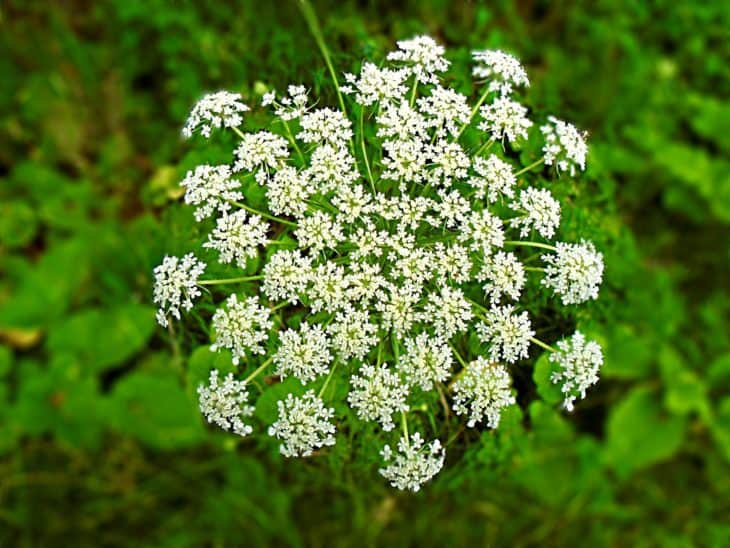
Poison hemlock (Conium maculatum) is a member of the Apiaceae family, native to North Africa and Europe. Hemlock leaves may look like carrot leaves, but this plant is not to be trifled with. While all parts of carrot plants are edible, all hemlock parts are toxic.
Related: 12 Plants That Look Like Poison Hemlock
Poison hemlock leaves have a compound pinnate structure that is lacey in appearance with a bright green color. As with other plants in the carrot family, poison hemlock forms a tall flower stem with multiple white flower umbels.
In the second year of growth, this biennial plant can reach a height of eight feet and can easily be mistaken for wild carrot plants. The hollow hemlock stems that lack a hair covering and have purple markings can help positively identify this plant.

